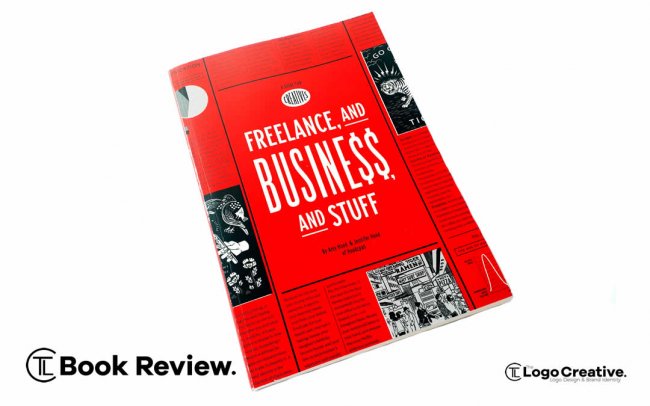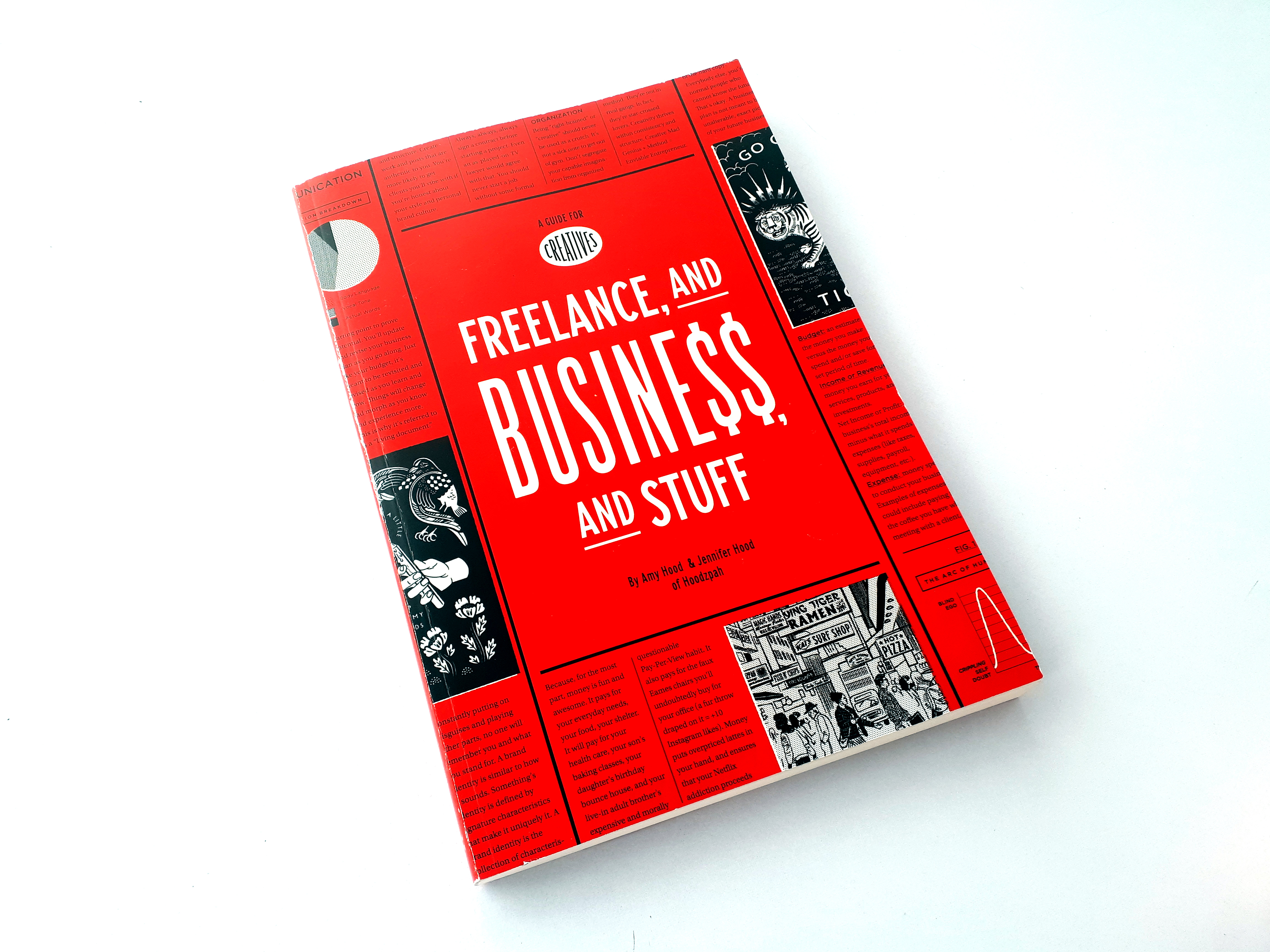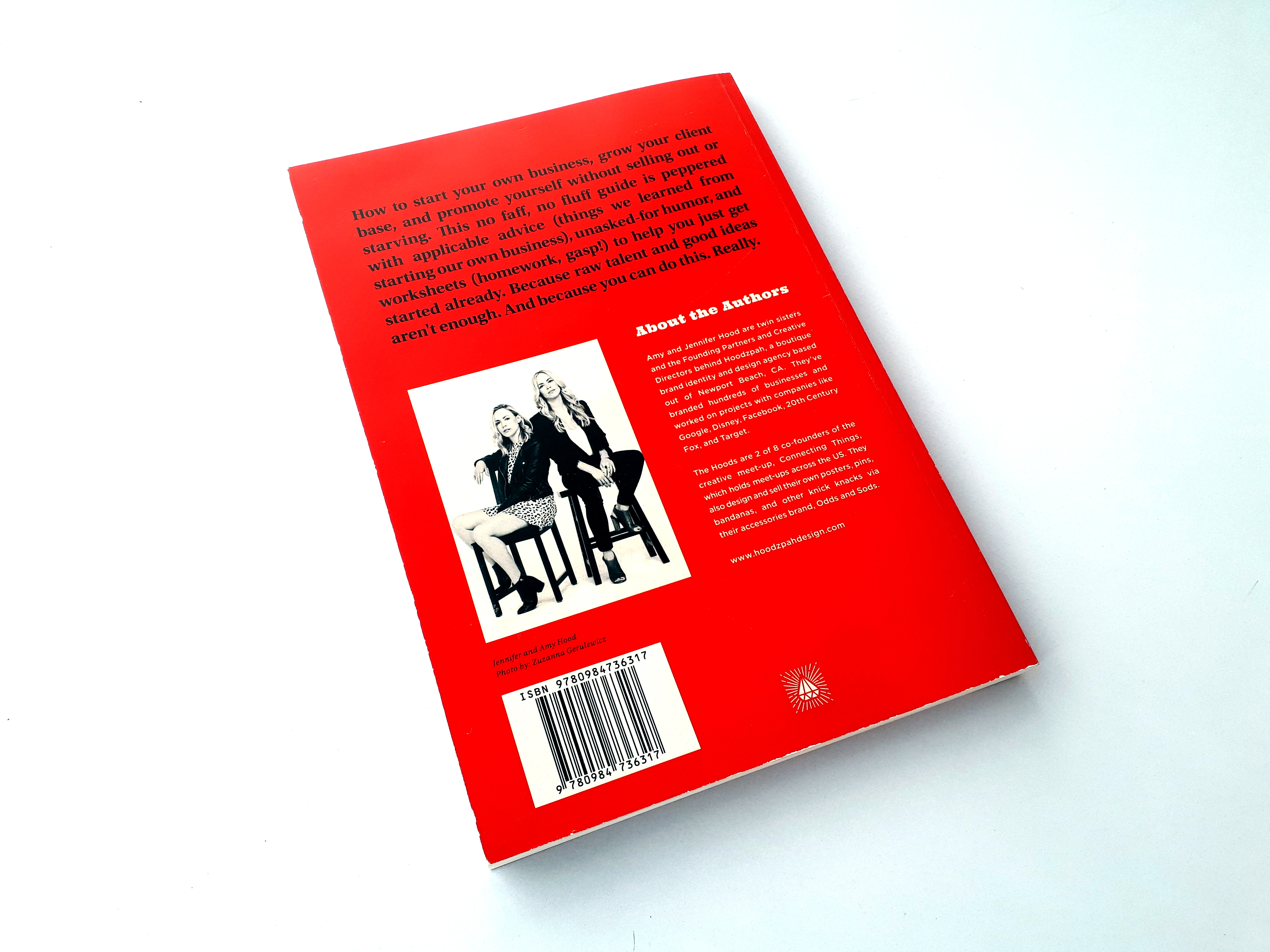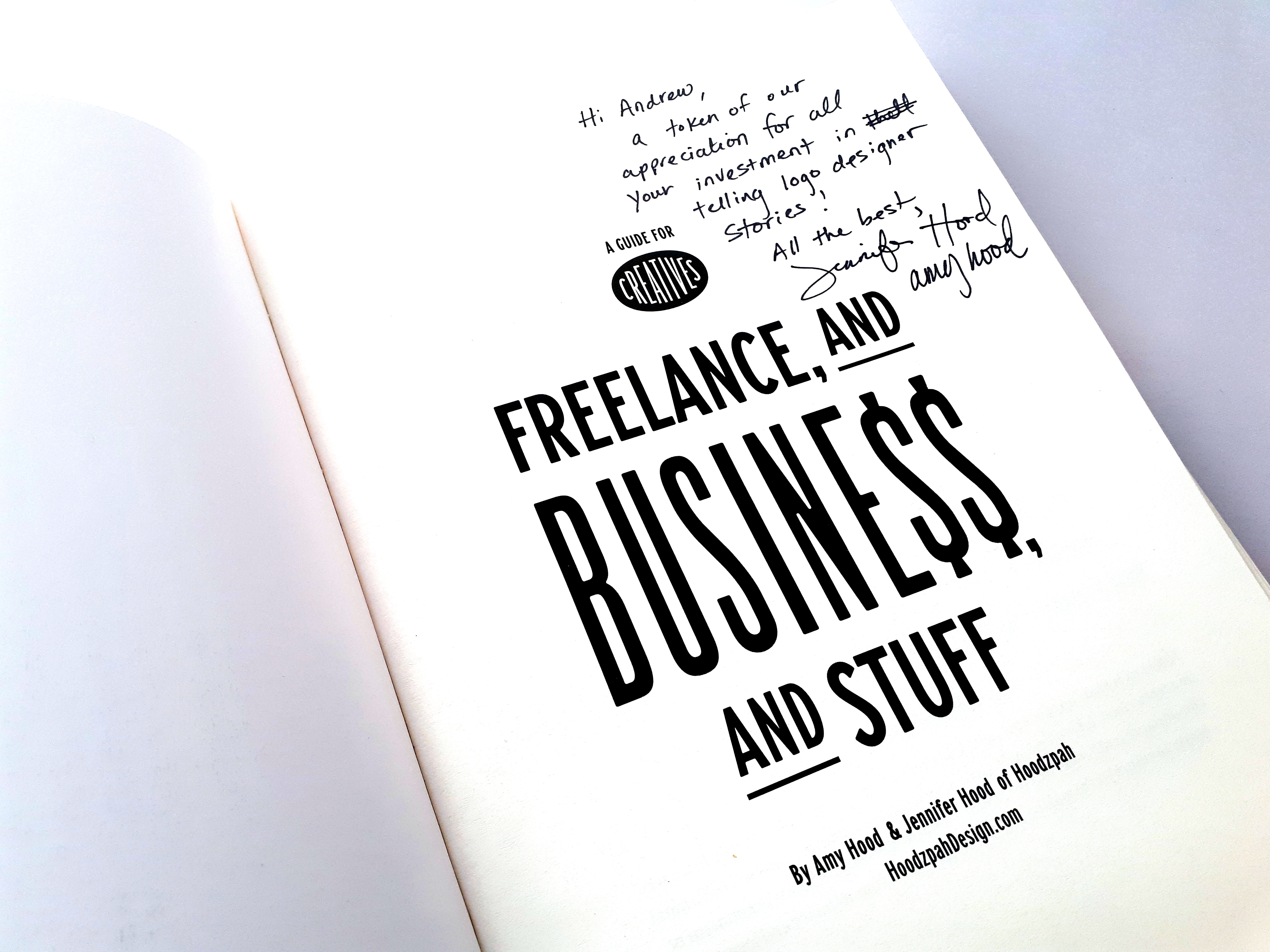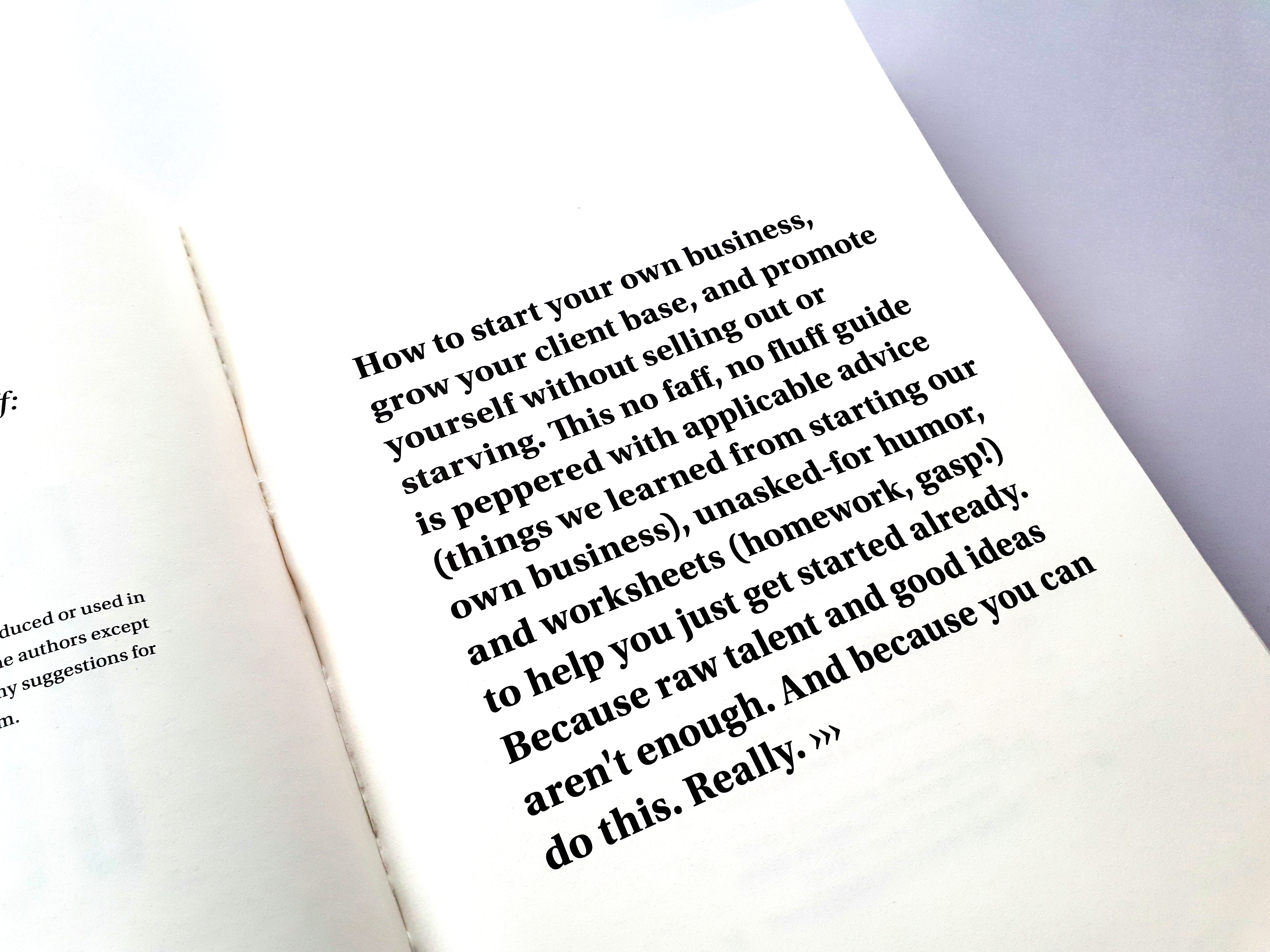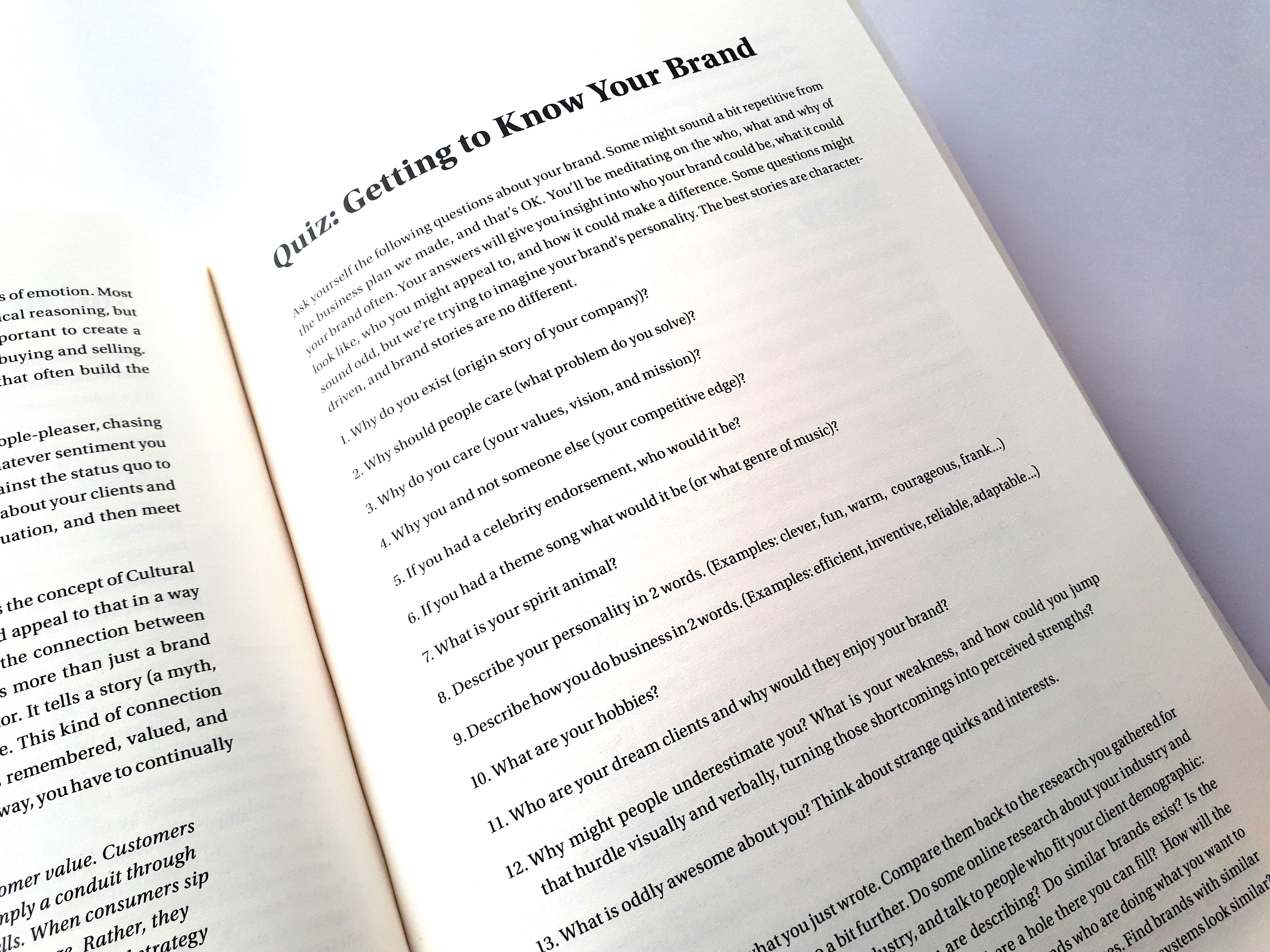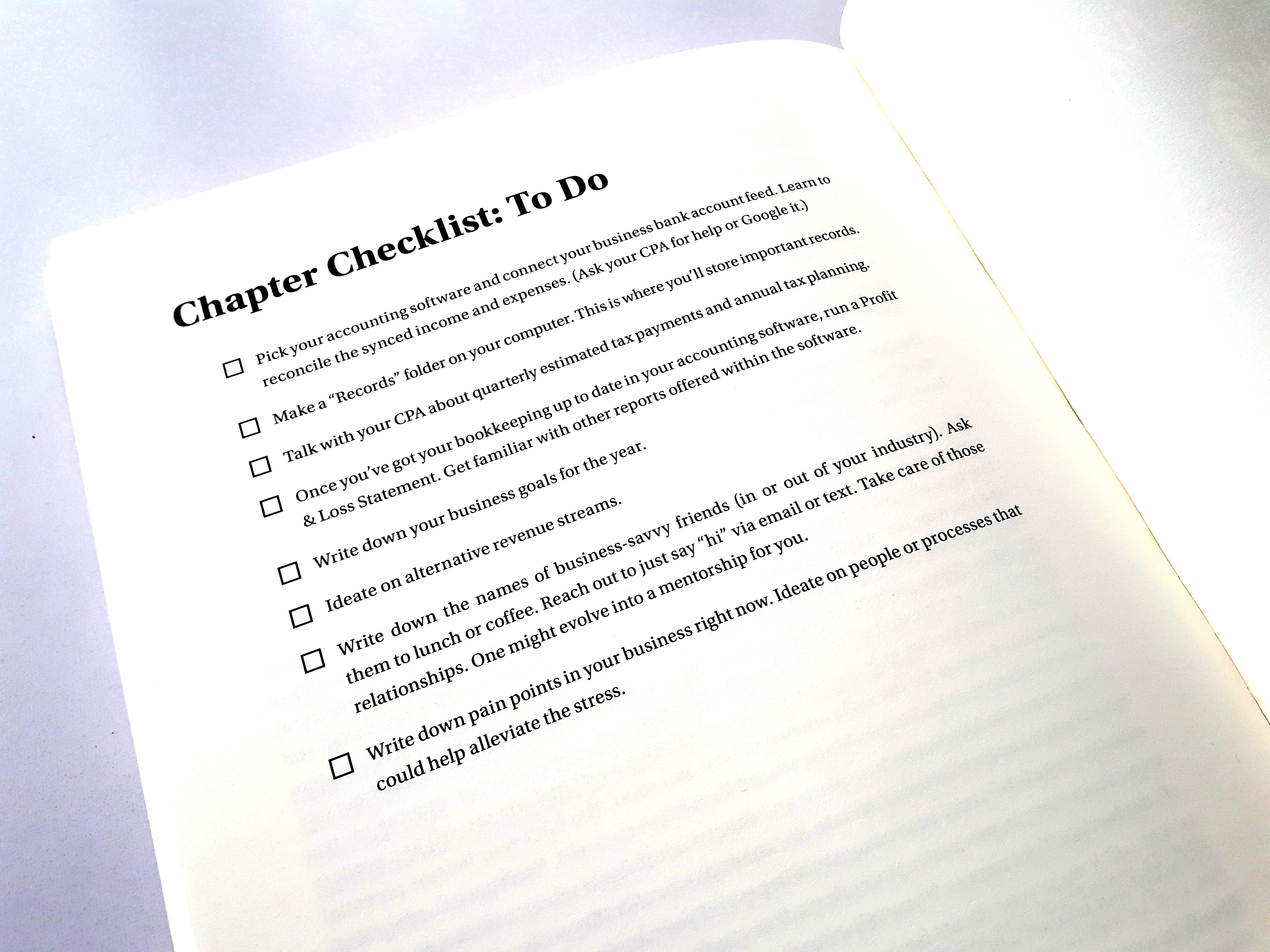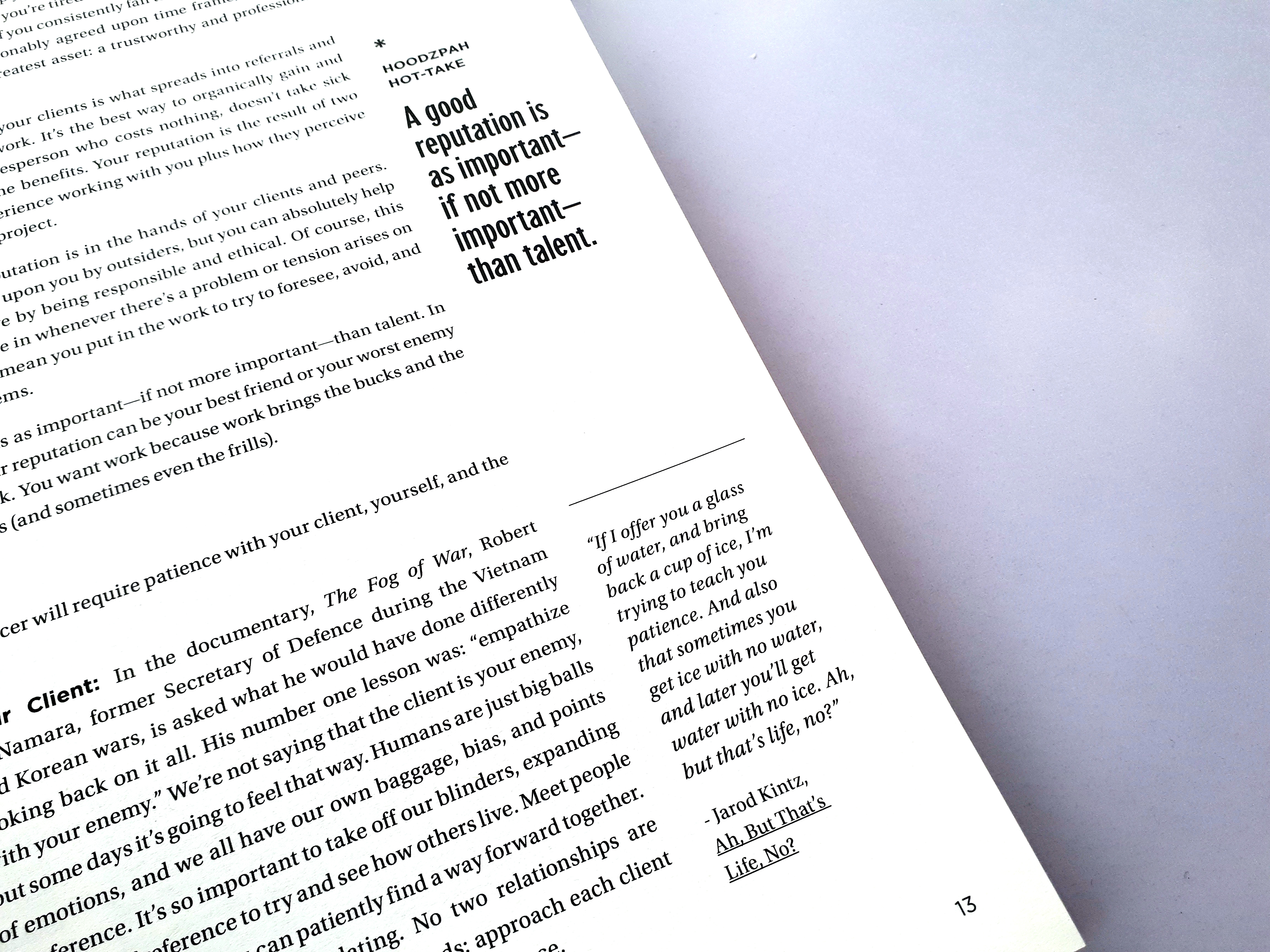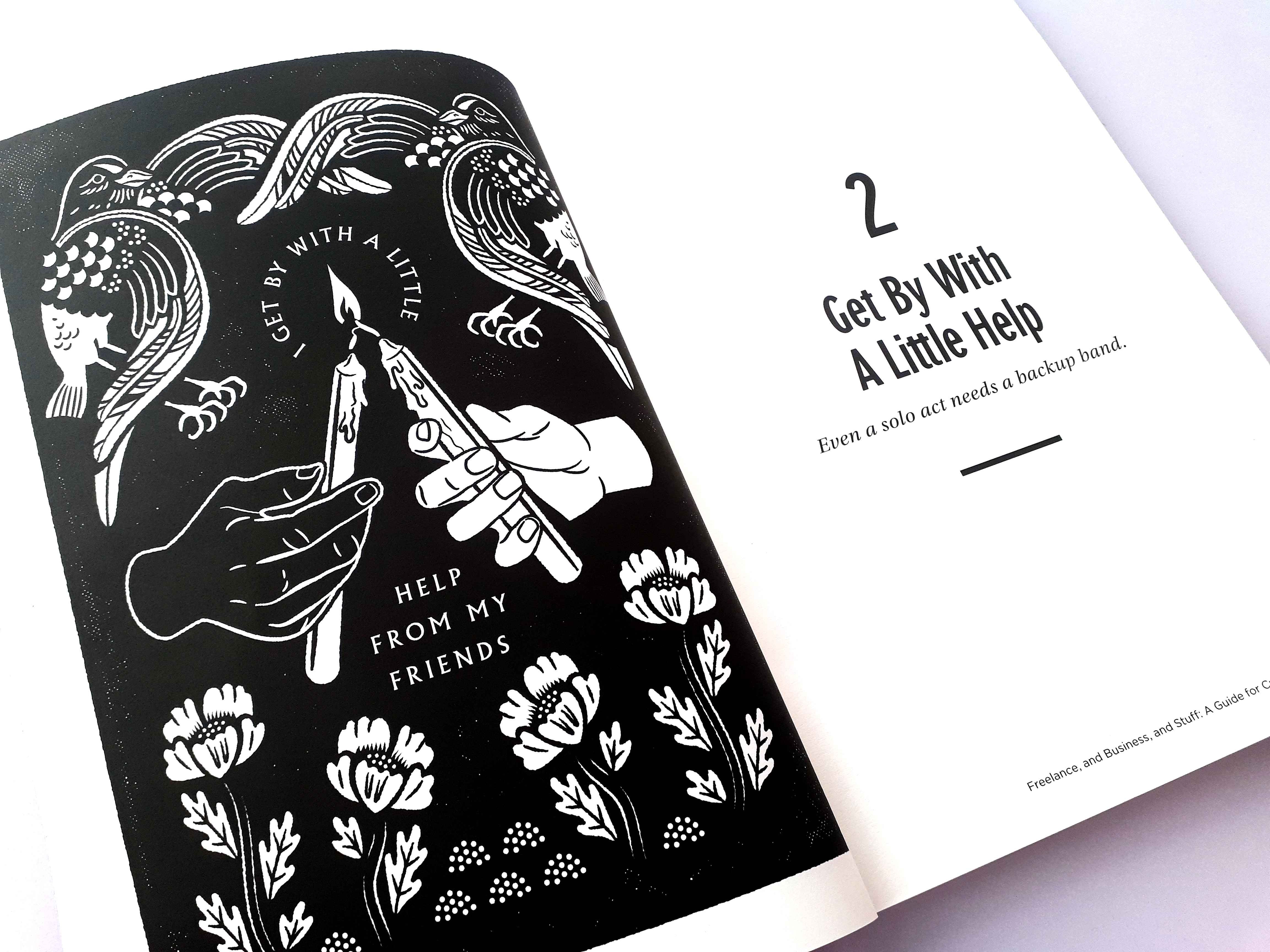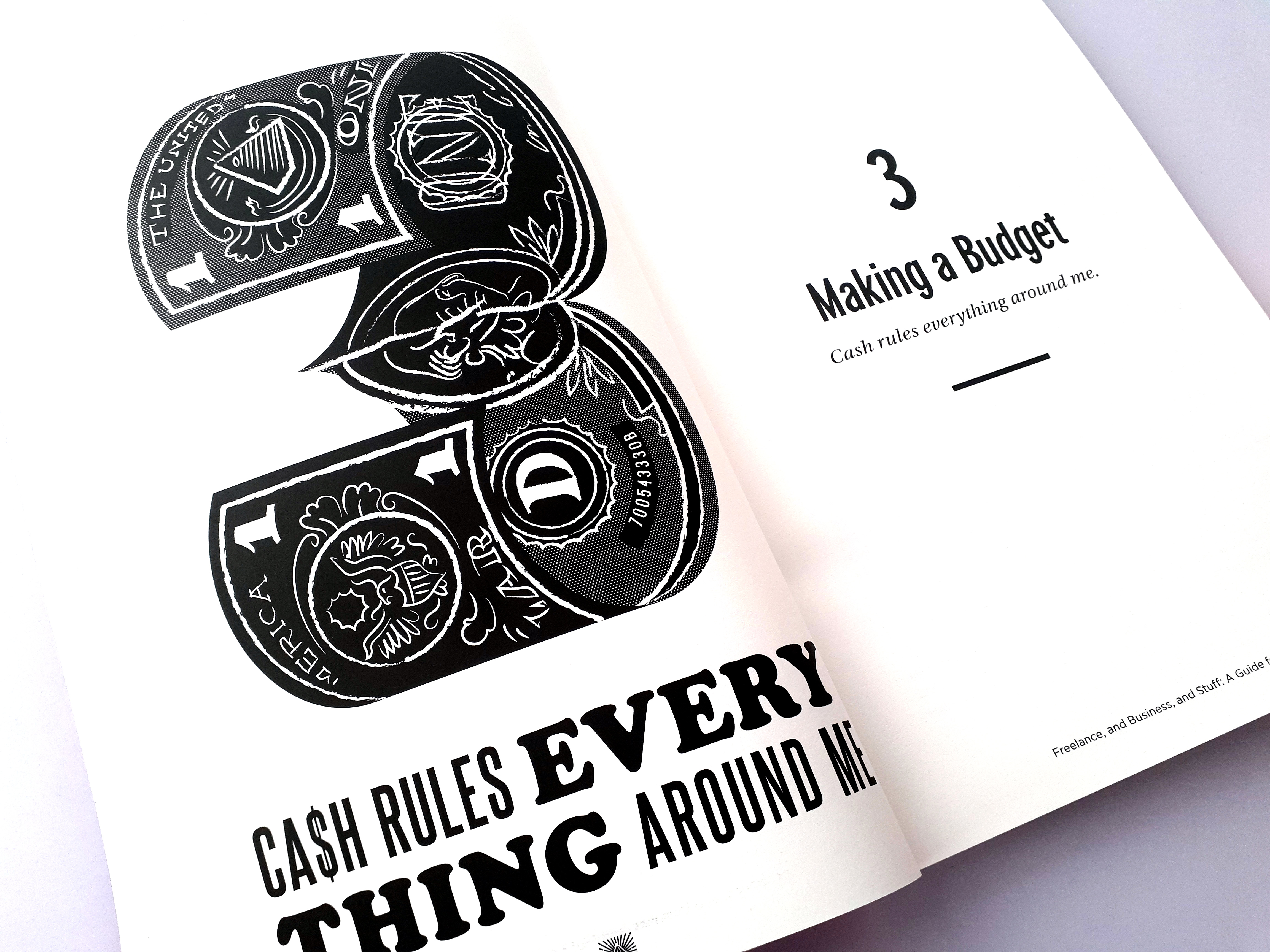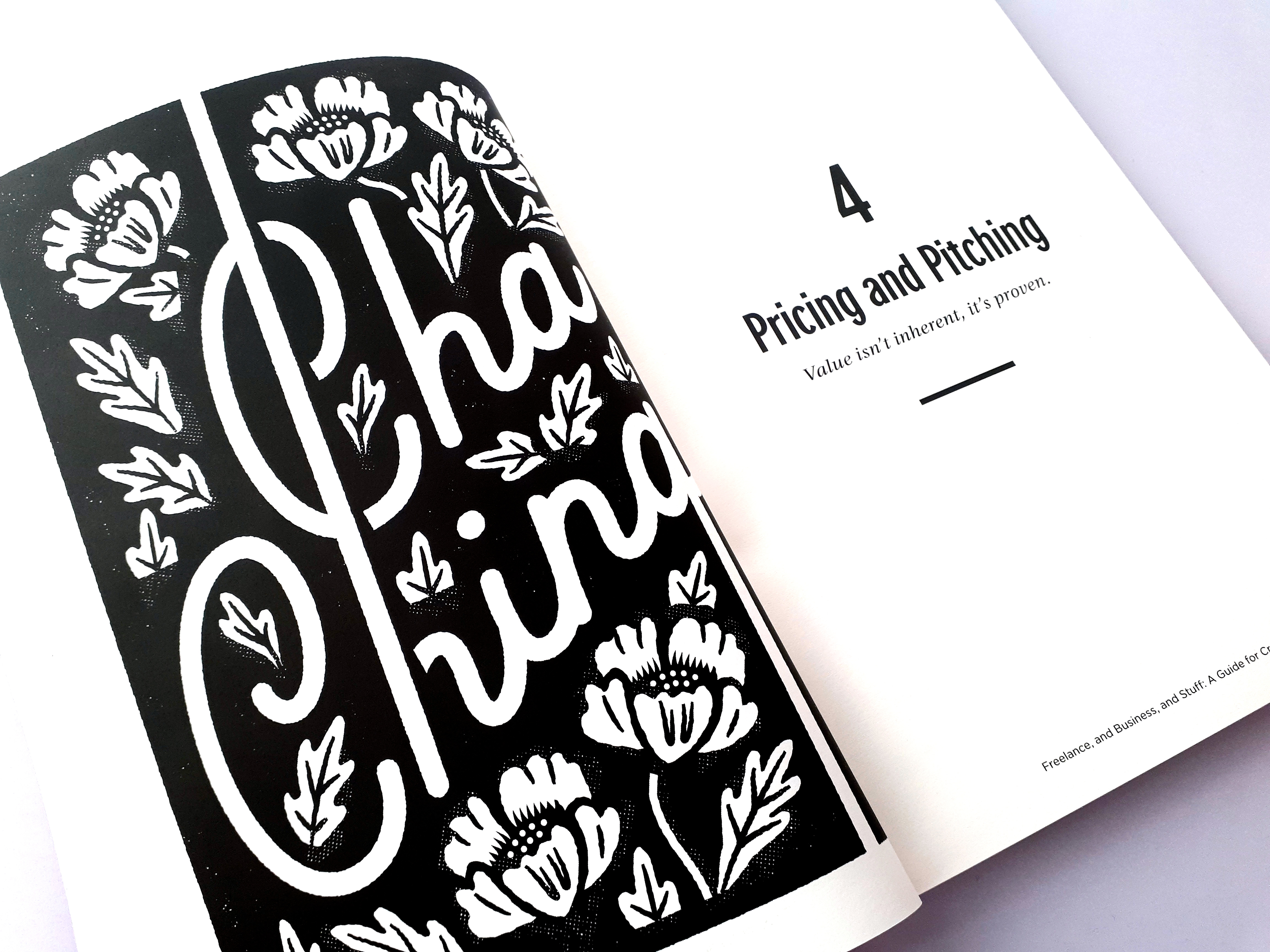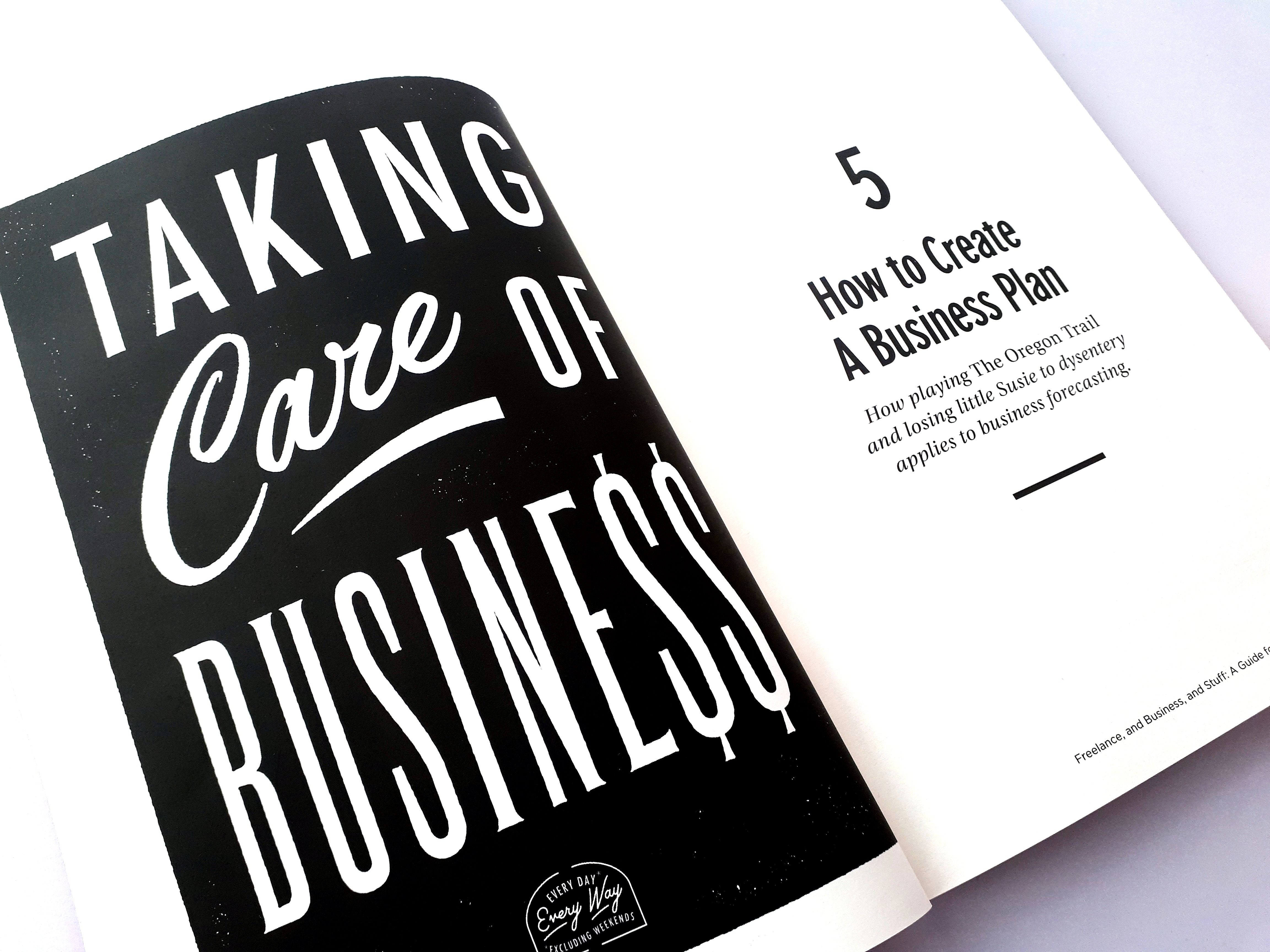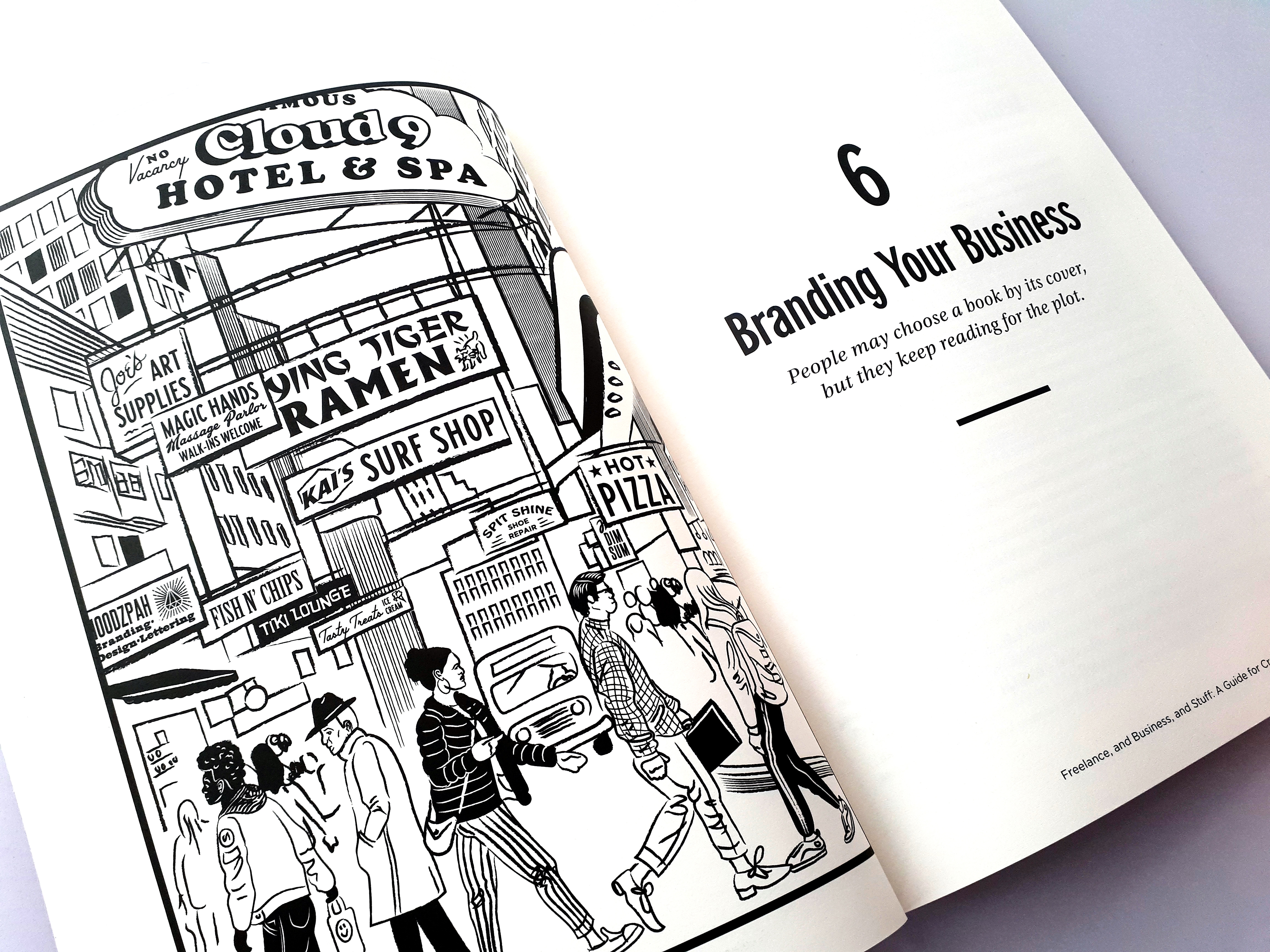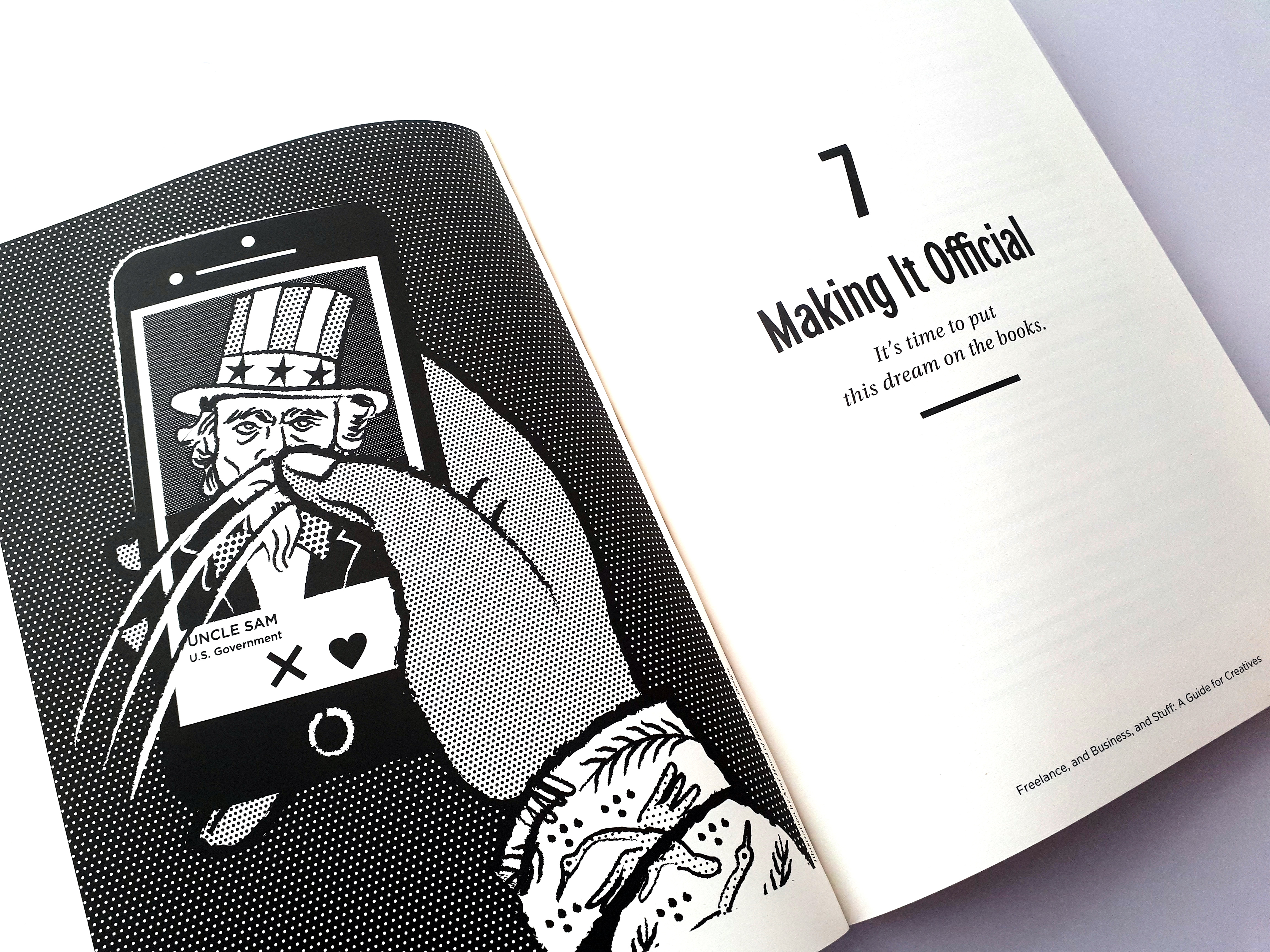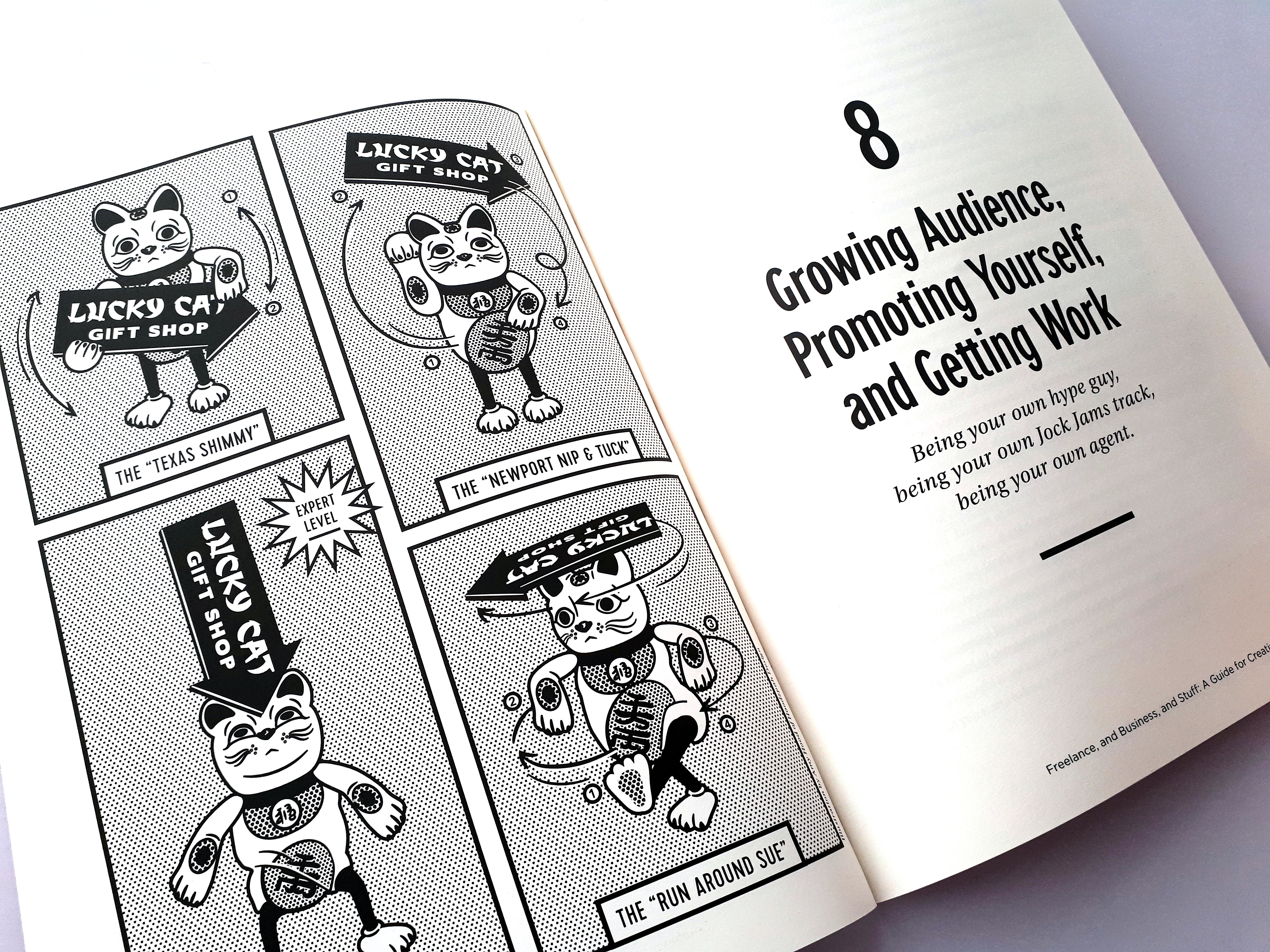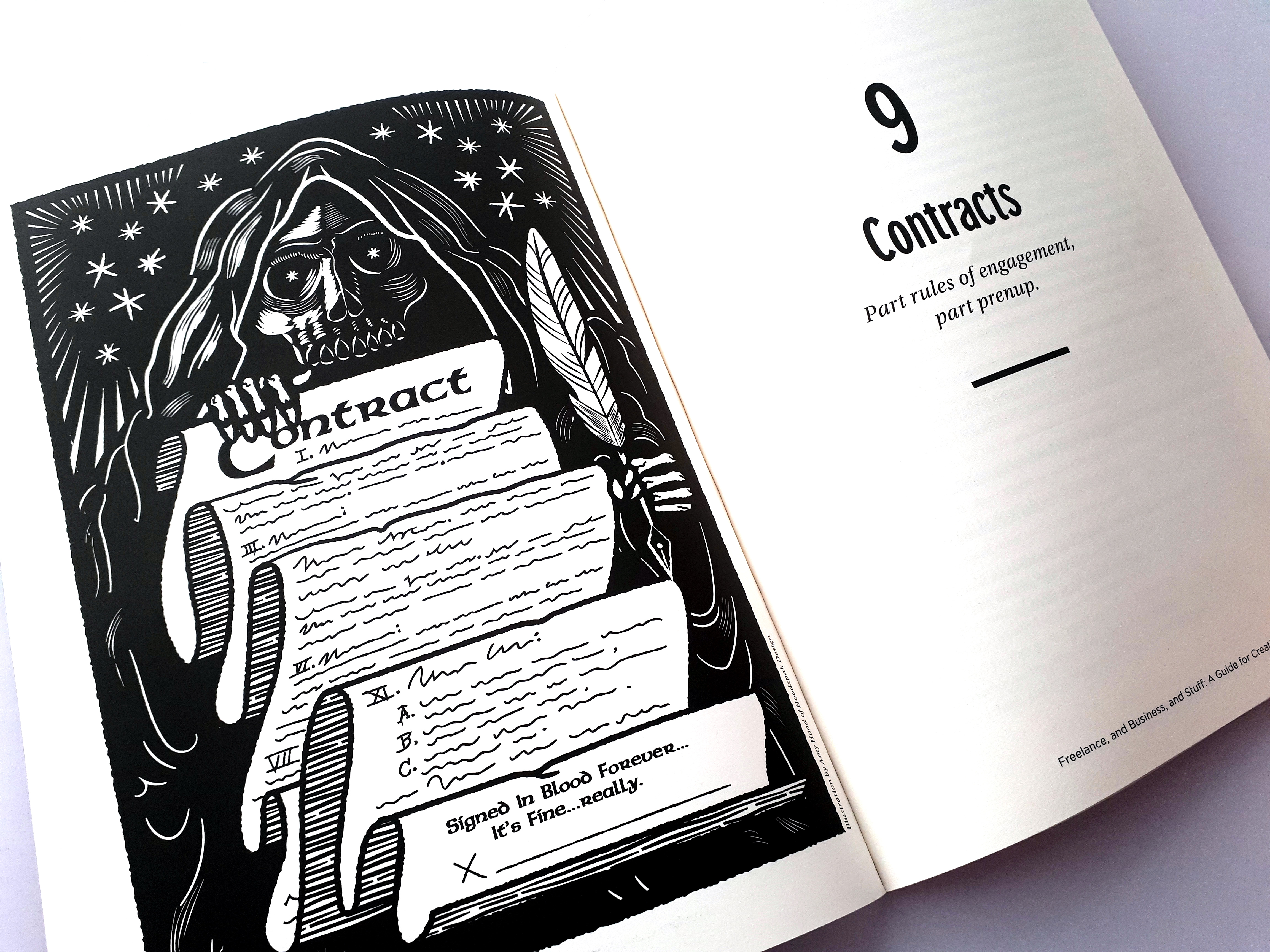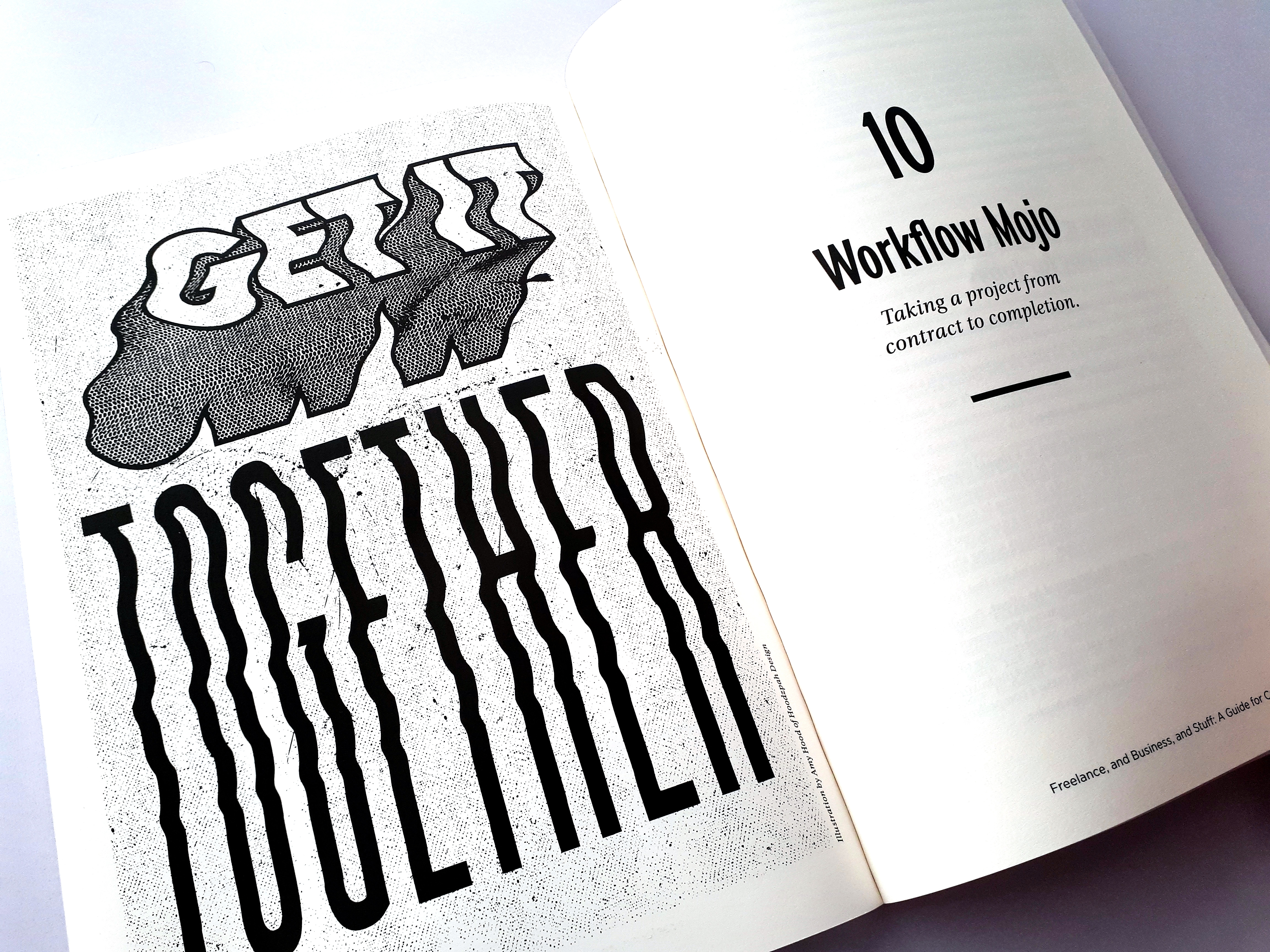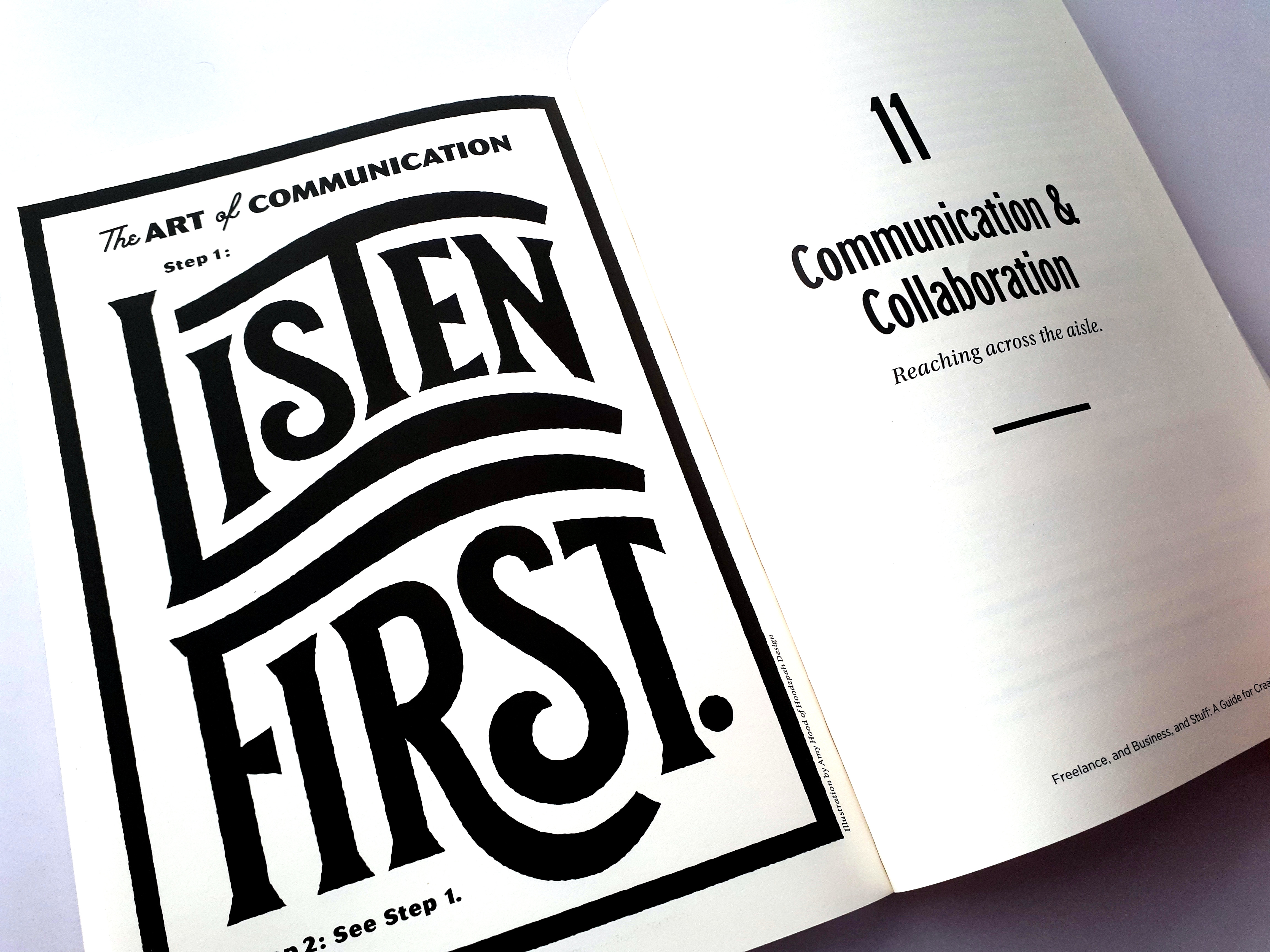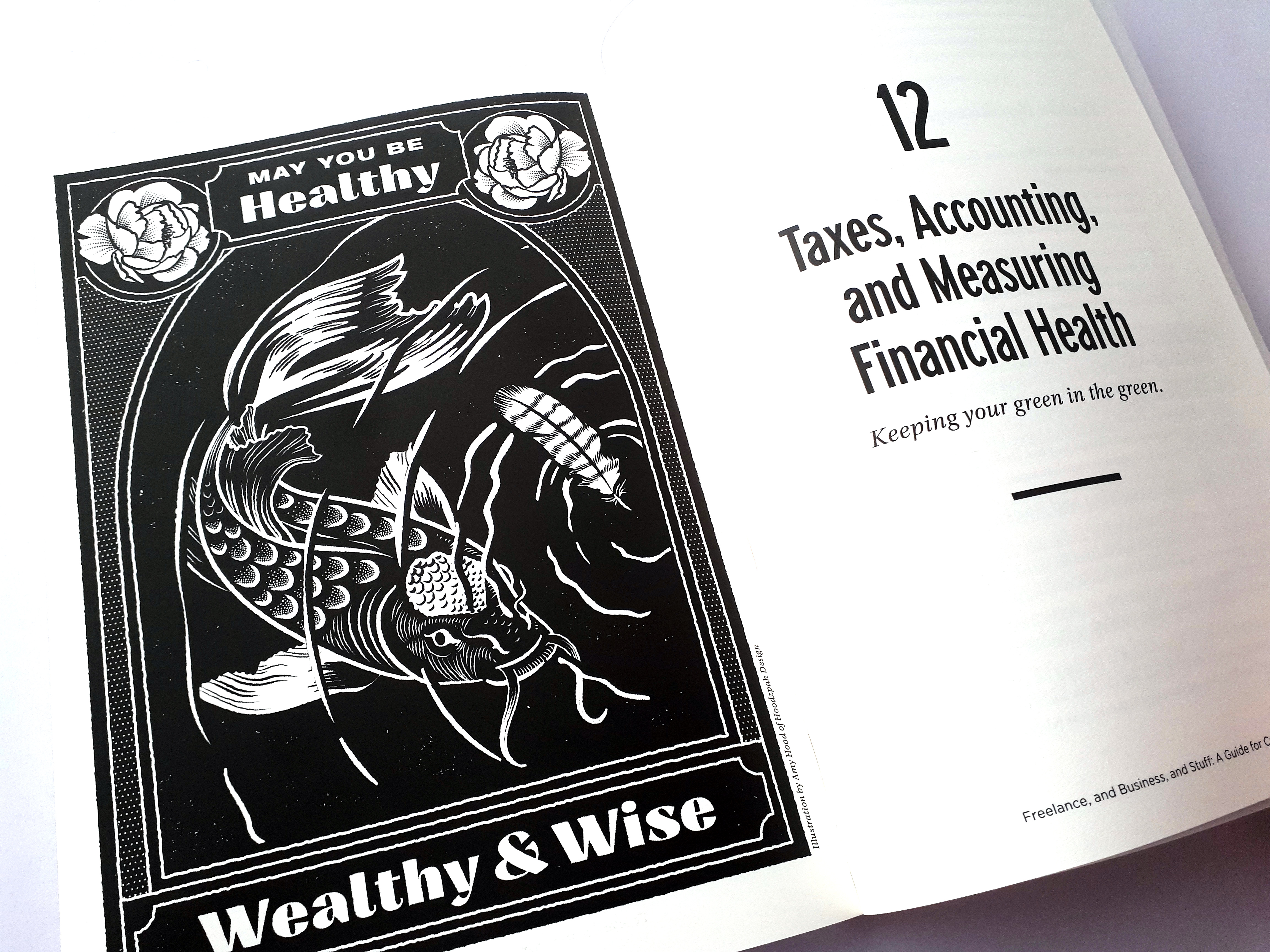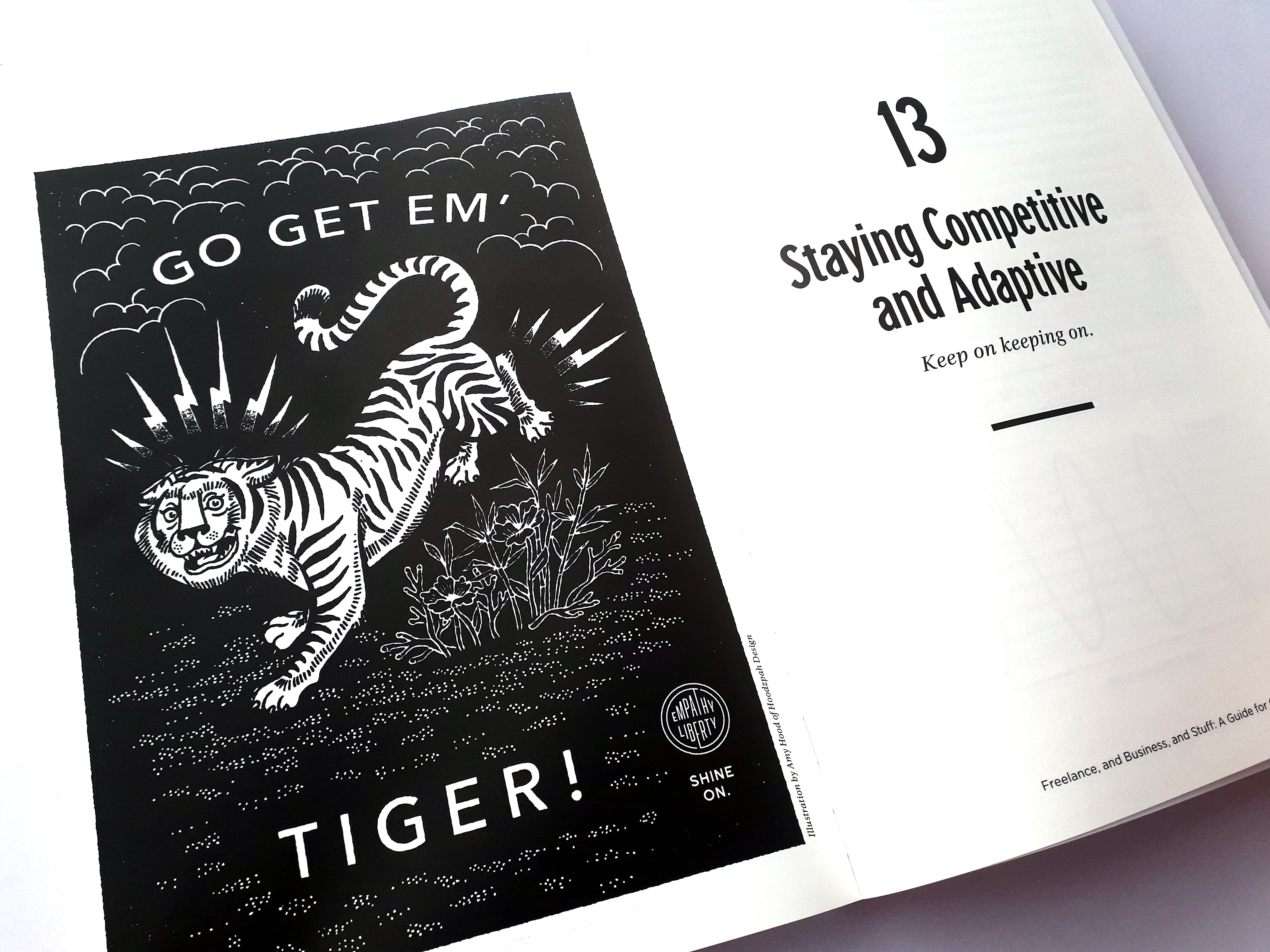Freelance and business and stuff is a guide for creatives and it’s written by twin sisters Amy and Jennifer Hood who are the founding partners and creative directors behind Hoodzpah, a boutique brand identity and design agency based out of Newport Beach, California.
The Hood sisters have worked with clients such as Google, Disney, Facebook, 20th Century Fox, and Target so from reading that client list you know the advice within the book will be of great value.
The book has been made up of their personal research and experiences while running their own design studio.
You can also read their designer interview to provide more insights from their life as designers.
They were kind enough to send me a signed copy to enjoy and I would like to thank them again for their kindness. It’s been a great read which I would highly recommend to creatives just starting out or established ones to get a copy to read.
Freelance and Business and Stuff is a well-written book that’s well structured and laid out with clear subheading and bullet points. The book has practical tasks and worksheets for you to complete which I think is a great idea as it gets you the reader involved in a practical way and each section has a checklist at the end for you to mark off when a task has been completed.
The book has a humor side which helps you read your way through the sections of starting up and running your own design studio making it easier and fun to read. A Lot of business books I have personally read in the past have tended to be a little too serious in the way they are written and I feel this makes them harder to read and process the information, but Freelance and business and stuff does it differently and makes it enjoyable and a fun read that is easy to digest.
The book has 13 chapters with each of the chapters having a beautiful black and white illustration illustrated by Amy herself.
To give you an overview of the content that you can look forward to reading about, we will go through each section of the book explaining a little about each chapter which includes:
- Do you have what it takes
- Get by with a little help
- Making a budget
- Pricing and pitching
- How to create a business plan
- Branding your business
- Making it official
- Growing audience, promoting yourself, and getting work
- Contracts
- Workflow mojo
- Communication and collaboration
- Taxes, accounting, and measuring financial health
- Staying competitive and adaptive
Another little thing I personally like as you go through the pages, down each side of the page there are little snippets called Hoodzpah Hot-Tasks which are little chunks of advice regarding certain areas, for example, the first Hot-Take is “A good reputation is as important, if not more important than talent”
Which is completely correct as a great talent will not get you far if you have a bad reputation, so these little Hot-Takes are nice little insights to take away from down the side of the pages.
The book includes lots of personal tips on how they do business at Hoodzpah, It includes everything from setting up your business legally, resources for insurance, bookkeeping handling your accounts, worksheets to help you work out those hourly and flat project fees.
If you need help creating a business plan business plan, setting up project workflow from the initial contract signing to completion with suggestions on promoting yourself, winning more pitches, presenting proofs and getting those approvals it’s all in there for you to learn from.
As Amy and Jennifer explain “We never thought of ourselves as writers. But we kept getting the same questions about how we started our business. After thinking about our mistakes, wins, and lessons learned, we wrote it all down into a freelance business book. Freelance, and Business, and Stuff is for anyone looking for more control over their creative career. Freelance can truly enrich your life. And you don’t have to be full-time freelance to enjoy the perks. It can be a way to make side cash to supplement your income; to test a new profession or skill without ditching your steady day job, and to work on projects that fulfill you (if you’re feeling stifled or stagnant at your day job). When you run your own freelance or creative business, it gives you more power to choose how you work (when and where), what you work on, who you work with, and how much you make. The gain is more flexibility and control. The tradeoff is more responsibility.
You truly don’t have to be a genius to start your own business, and you don’t need thousands of dollars. Heck, you don’t even need a college degree. Best of all, you definitely don’t need permission. But you do need patience and diligence in spades. Add common sense for making clear decisions, enough skill to do good work, a healthy hunger for knowledge, and a shake of pliability (adapting is key) and you’re good to go.”
This book is very good and packed with information and insights about running a creative business. It includes great insights given by two successful practicing designers running a creative business, they cover things you need to know about running a creative business and tips on how to run it successfully. This is what you need if you’re starting up a creative business or if your more seasoned then still read it you’ll learn something new or a way of doing things differently!
Ok let’s dig into the book to let you know what you can expect to read about as we take a look at each chapter and give you an overview.
Table of Contents
Chapter 1 – Do you have what it takes – A pep-talk plus the third degree
Chapter one is pep-talk as they word it and goes through areas you need to be made aware of before starting out on your own as a freelance individual you are responsible for everything even when things get rocky and there is no one to pass the book to. You have to wear many hats within your business and undertake and deal with many different areas while running a business as a solo freelance business owner you’ll need to maintain productivity and keep your reputation high.
Working freelance requires you to be very patient not only with your clients but also with yourself and the world around you. Organisation skills are critical as you take on new clients as well as dealing with existing clients being able to organise and plan your projects makes you work more effectively.
As business owners we don’t always know the answer from the get-go and it’s impossible for us to know everything but this does not mean we should make it look like we don’t know what we are doing, never be afraid to research something you are unsure about build a good resource for troubleshooting, build relationships with other professionals who can help and advice you in times of needs and be willing to return the favor.
Be honest to yourself and have a competitive ego as a healthy and competitive ego should encourage you to take the advice you need to improve.
Make sure you have the know-how before you set up shop. Are you skilled enough to handle the projects you’re seeking, can you keep up with advancements in technology and the software you use is the software your using right for the take you are doing? Always be learning and growing your skillset.
Make sure you have the relevant experience and portfolio to back it up to be able to get the work. Learn to guide your client to make an educated decision they may not know how to get to on their own. Should you delegate a task and outsource it because your time will be best spent on something else if you do decide to do this then you will need to learn how to manage that delegation effectively and can you justify the delegation cost?
Do you have the necessary equipment and space to work?, Is there a higher enough demand for your style of design and any gaps in the market that you can fill? These are all areas you need to think about when starting a creative business.
Chapter 2 – Get by with a little help – Even solo acts needs a backing band
This chapter covers some important areas when starting out your creative business such as making sure you have a business account as you need to keep business finances separate from your personal finances. Find a business mentor or someone you know and trust that can offer guidance when you need it and finding someone who has the time, experience and most importantly the interest in what you’re doing will be a blessing.
Finding a business accountant will be a very important step for your new business as they will help you keep your finances in order and also help save you money so make sure to get a qualified accountant to oversee your businesses finances.
When running a professional business having the right insurance is vital such as business insurance, you can also take out personal health insurance, life insurance, and professional liability insurance which is also important to cover yourself and your business. By running your business legally and above-board you’re less likely to run into issues later down the line.
Chapter 3 – Making a budget – Cash rules everything around me
This chapter goes into creating part of your business plan, such as a budget worksheet as its called in the book. This sheet is where you calculate all your expenses such as insurance costs, utilities for both home and office expenses, cost of running a vehicles or equipment and any personal care items such as hygiene needs, clothes, and medical out-of-pocket stuff to overall calculating your overall living costs so you know what you need to be earning each month.
The book includes an example of a handy chart/worksheet to give you an idea of how to set one up. The chapter also goes through how to calculate your desired personal income including taxes and checking your calculations against real industry averages.
The chapter looks at different scenarios such as embracing working from home, co-working, working remote and advising you not to jump at the first chance you get to upgrade your situation as you make money, if you’re spending it as soon as your making it you’re not really making money, as the girls explain the biggest trap of new wealth is to live to your means rather than live to your need so don’t let your expenses grow to match your income as you can never save money this way, which is absolutely correct and good sound advice. So budget for freedom and flexibility.
Chapter 4 – Pricing and Pitching – Value isn’t inherent, it’s proven
This chapter starts by going through flat rates vs hourly pricing and the pros and cons for each pricing structure. It also gives good examples of when you should bill a client an hourly rate and for example such as projects where the scope is vague or flexible. And production work that has a less defined scope such as work that already had a style guide defined and your just carrying out work based on this guide, so the work is not as creative.
The chapter also discusses how you can calculate your own hourly rate and goes through the steps you can take to round off this number. Moving on to the next section in this chapter is all about how to price a client with a flat rate quote for a project, it asks you a range of questions such as expected hours on this particular project? How big is the client you are quoting for? And a range of other questions you need to be asking the client.
The book also explains smart pricing and this is not based on the exact cost of the services rendered, but the value of your work. You need to find a balance between what you think the project is worth and what the project is worth to the client.
Focus on educating the client on your value rather than just price alone, it needs to be something that validates the client paying more for you and be loyal to you this reason is more likely to be your ability to deliver high-quality work, or your ability to understand their brands unique brand style and voice. Moving on the book looks at how you can increase your rates and charge more for your time and services, by looking at certain areas that may be telling you it’s time to start raising your rates.
It also goes into detail about how to respond to clients looking for a quote and how you should respond, just because a client wants a quote does not mean you have to give them one right away. Do you have all the relevant information to be able to quote? Is it a genuine lead? The book goes through several scenarios to help with the response you will be giving to the potential client.
The section goes on to describe pitching for projects and the different types of pitching that can occur such as formal presentations, power points, in boardrooms, over the phone and in person or video feed and the right combination of methods can lead to a winning over that dream client. As a quote is just a money amount with a scope a pitch is a way of contextualizing your quote to show the value behind it, and why you are the right fit for the client. Your proposal is your pitch on paper.
The chapter then looks at questions to ask potential clients to be able to fair quote a tailored proposal. and how to make the pitch you give resonate with the potential client both conversationally and within the designed proposal.
To end off the chapter the book discusses the case for doing free work and the case against doing free work. Some designers are totally against doing freebie work and other may in rare situations., caution must be made when considering this type of work such as who is it for? is it for a good cause? is there any value on your part for doing unpaid work? We as designers also need to get some value from doing this!
Chapter 5 – How to create a business plan – How playing the Oregon trail and losing little Susie to dysentery applies to business forecasting.
CReating a business plan is tough when first starting out, everything is new and there is a lot to take in, you also may be nervous at the thought of going in to business for yourself so this makes it even more of a challenge to put all the relevant details and information into a business plan this chapter breaks it down so its clear and easy to follow step by step.
It starts right at the beginning with the company overview
- Business name and legal status?
- Who are you?
- What kind of professional support system do you have?
Business offering
- Services you offer?
- Products you offer?
Market research
- Your client base?
- Market demand for your services?
- Competitive landscape?
Marketing strategy
- Ways to reach potential customers?
- Resources needed to execute your marketing strategy?
We then move onto the financial plan which looks at defining your revenue goals and estimated expenses, the book includes some handy questions you can answer to determine these numbers. Most of the questions have been answered in chapter 3 so you can refer back if needed.
We can’t forget about the almighty question we get asked on a daily basis “what do you do?” if put on the spot can you give that person asking the question a powerful sentence or two that is going to sell your business to that prospective client asking the question.
The value proposition statement needs to include your products and services, why is it valuable to your consumer and why they should pick you over the competition.
Chapter 6 – Branding your business – People may choose a book by its cover, but they keep reading for the plot.
This section starts by explains the difference between a logo, a brand identity, and a brand. It has a handy quiz to help you get to know your brand, the answers will give you an insight into who your brand could be, what it could look like and the people it will appeal to and how it can make a difference.
90% of what you can’t see is the brand like the universe, a dark matter, it’s then important, but its intangible. Your brand is a combination of the story you tell and the audience’s reaction to that story is a collaboration between the brand and the world around experiencing it and not something you can completely control.
The other 10% the world sees is the brand identity, the branding is the heart and soul and the brand identity is the skin and bones of the brand, known as the identity system. Which is a set of visual and verbal assets that give style to the substance of your brand?
The book then looks at business naming and areas to consider when choosing a name.
- Availability
- Originality
- A deeper meaning
- Creating your own meaning
- Clarity
- Social media
- Aesthetics
A company tagline is a great place to build on your brand theme and story, taglines can serve to give more pertinent information about your skills and offerings. If your company name is unfamiliar then taglines can help people understand what you do or why you do it.
When designing a logo for your own business it’s best to treat yourself like your own client and a regular job when designing for yourself. Don’t skimp on research and do a correct discovery phase, sketch concepts and seek critique and feedback on logo concepts from trusted peers and mentors.
Develop the correct style guides for fonts, colours and other treatments that will be used throughout the identity system
Tips for designing a logo have also mentioned that include:
- Classy beats trendy every time
- Consider the clients you will have in a short-term as well as those dream clients
- Make sure the logo is unique to you
Messaging and tone of voice is also something you will have to learn and so much as learning how to be a great writer but being able to communicate to your audience in a way that they can understand and relate to. Get over any fears of writing you may have as writing emails and proposals will become simpler and less daunting. Pitching to clients will become much better and you will be able to explain proofs and annotations far better.
You will be able to connect with potential clients online through blogging and writing portfolio’s to explain the work you have done and the process behind it. Overall your general efficiency will rise also. The section ends with some tips on how to tackle writing about yourself and your brand.
- Writing with a goal
- Have a process
- Be genuine
- Choose words carefully
- Have ready-made content
- Company bio
- Value position statement
- Services list
Once you have your logo and core messaging its time to create simple brand guidelines the goal being to create a recognisable and cohesive aesthetic for your brand meaning it makes designing future collateral for your business much more efficient. Brand guidelines can include:
- Core brand fonts
- Brand colours
- Do’s and dont’s
- Mission statement, value proposition, key messaging and brand tone.
Designing business collateral is also important and you need to be consistent when creating such material you will want to create business cards, flyers, compliment slips, social media images, flyers, and all that good stuff. Think about a reasonable budget you can work with to create yourself a professional and unified set of collateral that will help promote and sell your company as the capable, exciting and professional outfit it is to prospective clients.
A business website is one of the most powerful marketing assets you have. Getting this right is vital and the first place a potential client will look to gain information about who you are, the process you follow, and the work you have done. Spend time to think about how you will proceed with designing or having your website designed there are plenty of options out there.
You should always be aiming to put yourself out there and aim to be as transparent as possible.
Chapter 7 – Making it official – its a dream to put this dream on the book.
When starting a new business you need to think about your business structure and the type of business you will be running, for example, are you a sole proprietor and running your business as the sole individual within the business and responsible for all business decisions, business debts, losses, and liabilities.
Or perhaps your going into a partnership with a business partner and structure the business with two owners and decision makers who will be sharing business duties and profit and losses through the business.
There are other forms of business structures such as an LLC (Limited Liability Company) which is a mixture of a partnership or a sole proprietorship structure and the most complicated corporation structure that still has your business income taxed as personal income with the benefits of limited liability which means you are not personally responsible for legal debts or legal claims against your business.
The final type is a corporation and the most complex structure that includes many ongoing requirements and there are two types (S OR C) basically C corp is is the standard and S corp has a special tax status with the IRS and the biggest difference being in the way they are taxed and the book explains in more detail the difference.
The book then goes through which business structure is right for you and obtaining licenses and permits and registering your business name and getting familiar with business laws and regulations that apply to your business.
Chapter 8 – Growing audiences, promoting yourself, and getting work – Being your own hype guy, being your own jack jams track, being your own agent.
In this chapter, the book dives into the fun stuff with tips about getting your business in front of potential clients with the goal of doing this cheap and easy as your starting out on that small budget and “I can do this” attitude.
Potential clients are everywhere! Don’t always have that car salesman approach when meeting people, think about how you treat people in general because you are your own brand and the face of the company that is a key factor in your brand’s experience. Conduct yourself in a professional manner and be a decent human.
When you’re in business you need to be on the ball and respond to work inquiries promptly. Remind people that you exist and stay on your audience’s radar. Post your creative work regularly on social media. And keep a good line of communication open without a hard sell and engage with clients on social media.
You can also reach out to potential clients, research your dream clients follow those people on social media and start interacting with them and casually build rapport.
If they have a contact form on their site drop them a short email, let them know why you do what you do! And what you can offer if they need creative services with a link to your website and work. You have nothing to lose by reaching out and stand to lose a potential client if you don’t reach out!
The book then dives into getting your work noticed online by using online services such as Dribbble, Behance, Medium etc as springboards as those websites are highly indexed with a large amount of traffic going to them including potential clients.
When uploading work shows a little of the project with a link through to your websites portfolio and encourages visitors through to your website to see more of that project. This is good for SEO as these backlinks from such high ranking sites will help boost SEO ranking in the search engines like google.
You can also create high-quality content about your industry and work by vlogging on youtube, posting a story on Instagram and blogging on your website. The book also gives some brief tips on ways you can improve SEO on your websites such as if you’re using WordPress using SEO plugins, doing your keyword research for your website pages, post, and portfolio entries. Using Google AdWords and the keyword planner etc.
Using social media platforms such as Twitter, Instagram, Facebook, Pinterest, Dribbble, Behance, Medium etc to share work, your vision, and your brand. These platforms create opportunities for you to connect with peers, mentors and potential clients all over the world.
The chapter then touches on separate social media profiles for business and personal and gives pros and cons of doing this. And doing a google search on yourself to make sure you remove anything you don’t want people to find and/or removing old accounts.
The book then breaks down each social media platform describing the different platforms and their different benefits and angles to what you can post content for that will work best per platform. Then followed by useful tips for using social media to your best advantages such as being genuine, and providing engaging, useful and interesting content with the correct hashtags and a bunch of other useful tips.
Moving on to having a content strategy and measuring your social media success and how to deal with the rusty side of social media when thing don’t go smoothly.
Chapter 9 – Contracts – Part rule of engagement, part prenup.
This chapter dives deep into probably one of the most important things you need to have in place when working as a creative and that is a contract between you and your client. The chapter starts with some resources for creating your own contract and then goes through the key things a contract should include which is very helpful as creating a contract is quite a daunting task to be assigned with.
The chapter ends off with considering E-Sign Technology as at the end of the day who wants to print off a contract to then sign it and then scan it in the computer to send it back, this is a real pain and as creative we want to make it simple for our clients.
Chapter 10 – Workflow Mojo, Taking a project from contract to completion.
As creatives, we are the best candidates to be entrepreneurs. Think of it like this a lot of entrepreneurs who are not creatives spend a tone of money on creative things designed such as a identity design, website design, design collateral, building social media presence and crafting a unique brand experience and that’s a hell of a lot of money spent right there! We as creatives can do all this and don’t charge ourselves a penny! As creatives, we relish solving problems in a way that delights our audience and this is the core of what great entrepreneurship is all about. Embrace the fact that you’re the best candidate to run your own show and be your own boss.
You have all the qualifications you need, and once you get your everyday system and procedures in place there will be no stopping you and the world is your oyster.
The book then takes you through a typical workflow at Hoodzpah explaining 15 detailed stages. Moving on to explaining and showing how they organize their project files, time management and managing responsibility and scheduling with project run sheets, job calendar, and a personal to-do list.
Chapter 11 – Communication & Collaboration, Reaching across the aisle.
This chapter looks at avoiding communication breakdown and how your brand hinges on the relationship your client have with you and your business. It goes through some communication missteps to watch out for such as
- Cussing – How you should proceed with caution and know your audience.
- Oversharing – It’s healthy to keep some distance between you and your client and don’t air all your dirty laundry on the line and show some pride.
- Gossiping and Whining – Never speak negatively about clients in front of other clients, and gossiping gives off the impression you don’t respect other people’s privacy.
Keep thing positive and find common ground that both parties can relate to, don’t let those conversations develop into gossip or ranting about other clients.
The chapter then describes the different communication methods such as in-person meetings, phone calls, and emails.
Including 8 detailed tips for emailing like a champ and when texting clients to proceed with caution. To finish off this chapter the book talks about the checks and balances of verbal and visual communication such as making eye contact and looking engaged and interested the book goes into more detail about both nonverbal and verbal communication
Mood Boards
The book touches on mood boards and visually defining them as they mention in the booklet the client explain to you what they mean by further describing and giving examples. Then interpret. Picture is worth a thousand words – create a mood board with your client with visual examples and now your client is visually and verbally on the same page but together building a shared and mutually understood terminology and a client approved mood board helps get your client back on track when they get distracted throughout the process as it’s easy to forget about original goals.
Presenting a Proof
When presenting a proof show the client that the solution meets your mutual goals for the project and use the clients own words in the presentation. Go the extra distance and contextualise the work when possible and the creative process can be thwarted by subjective opinions from the client and the best way to avoid these infuriating subjective and emotional feedbacks from a client such as “I just don’t like it, I don’t know why.” is to make the research and project proofs analytical and specific and always show how the work you did directly relates back to the approved mood board and core project goals. If the work aligns with these things, then a client’s subjective feedback becomes irrelevant in the face of facts. If a client is smart, they won’t let their personal biases detract from the proof that meets the project goals and best serves their target demographic.
Saying No is Okay
As professionals, it’s our duty to and right to say “no” when we think it’s in the best interest of your client’s project be vocal about it when we fear a decision could derail a project’s success by been calm and analytically. If a client will not listen a choice needs to be made either to follow instructions or terminate the project early.
Breaking Up With Clients is Allowed
This section discusses why you may want to end a client relationship and why you need to have a clear and flexible termination clause in your contract. Some of the reasons why you may want to call it quits.
- Harassment
- Time Issues
- Money Issues
- Butting Heads
- Tragedy
Chapter 12 – Taxes, Accounting, and Measuring Financial Health – Keeping your green in the green.
This chapter goes through the difference between accounting and bookkeeping and getting started with software to keep track of your accounts and bookkeeping, The book has a handy chart displaying how long you should keep certain records and a section about anticipating taxes.
The chapter ends off with analysing your business success including information about how to go about doing this which includes some helpful insights you can read about.
Chapter 13 – Staying Competitive and Adaptive – Keep on keeping on.
This chapter is all about not losing your touch with your industry or the world at large. You may go through stages in your career when you feel like you have lost your edge or interest or trends change and you feel left behind.
If this day comes to give yourself a hug and snap out of it.get yourself out there and dig into new methods, movements and technologies, broaden your sphere of peers and influences by attending conferences. Do something outside of your profession that gives you a new creative outlet just don’t blame it on the era or industry.
Styling Adaptive
Challenge your ideas and test your assumptions on a regular basis, thinking you have everything figured out is missing out. The more you learn the more reference you have for balanced conclusions. You’re never too old or experienced to learn new things.
Addicted to Being Right
When we are found to be right in a situation and validated for making the right choice, the reward part of our brain lights up and this feeling can be addictive so naturally, we seek this feeling time and time again.
As our skills grow and we are rewarded for a job well done this triggers that addictive reward response in our brain and we continue to chase that feeling of being right, it’s natural that know one wants to be wrong and it’s a natural desire to be a winner and not lose.
As our careers get further along we encounter less healthy ego checks and critiques. As children and teens, we were regularly corrected and critiqued by teachers and parents as we learned and grew. As we step out on our own we start embracing our independence, this is an exciting time as we are on a journey of self-discovery and we stopped looking for feedback and critique from people as our lives are evolving and it’s easy to start thinking were above it all. Don’t impose this same kind of mentality on your own life and creative work.
The book then looks at areas that may determine if you’re a creative dictator by going through scenarios. And finishing the book by talking about staying competitive by staying up to date with evolving technology and not being afraid to try new software programs, investing in the community by contributing and promoting alliances with peers who understand you and may be able to offer advice. Getting involved in online creative communities like Dribbble, Twitter etc. There are so many ways to meet people and the hard part is playing an active role so commit to engage!
Seek Inspiration in the Unfamiliar
Not so much seeking online for inspiration but getting eyes on, hands on out of the box creative challenges such as getting a hobby outside of your job, something to unwind but will challenge you to grow your creativity in uncharted ways.
Take breaks and holidays, go on an adventure maybe drive a different way home you did not know or go to a different coffee shop something simple but different.
Sometimes the simplest deviations from your regular routine can expose us to something magical and new, leading to new ways of thinking and a possible resolution on solving a problem.
Don’t spend too much time working that you don’t have time to absorb the new and unexpected. Don’t become stagnant as stagnation leads to frustration which stems to resentment and you don’t want to see the world as the enemy instead of the proverbial oyster.
Q&A With Amy & Jen Hood
The Logo Creative – Have you always wanted to write a book? And was there inspiration to writing Freelance, and Business, and Stuff?
Amy & Jen Hood – No, we wrote it somewhat on accident. We were invited to do our first ever conference talk at Creative South about how we started our business and being overzealous, we took it a little too literally. We outlined exactly all the steps we took to starting our business. 60 Pages later we realized this wasn’t going to fit into a conference talk, and turned it into an eBook instead. 3 years later (last year) we began to rewrite it and revamp it based on all our latest discoveries and lessons learned now that we’re almost into year 8 of our business. This physical book is the updated release.
The Logo Creative – Do you always work together from the initial concept to the final outcome, is there a certain approach you take?
Amy & Jen Hood – We always concept and strategize together, but then we have one main lead on the design. It’s not efficient and too competitive when we’re designing against each other on a project. Rather, we delegate things within a project based on who best fits the need, and then we reconvene for critique and fine-tuning. Each client has one point person so they don’t get confused on who they’re working with.
The Logo Creative – How would you describe your approach to design?
Amy & Jen Hood – Practical but fun. We’re moderates when it comes to team style or team function. We think you can find a happy medium between something that works well and also is interesting/exciting/engaging to look at and experience. There’s usually something unexpected, irreverent or cheeky about what we do. We’ve never been accused of being serious or minimal. We tend to overdo it just a tad.
The Logo Creative – Who are the people who have influenced your aesthetics and your approach to design?
Amy & Jen Hood – Like many designers, our first design influences were the band posters or album art for bands we liked. So poster shops new and old from Hatch Show Print to Aesthetic Apparatus were early influences. Then we discovered old greats like Push Pin Graphic. Even before that, we were obsessed with old Disney concept artists involved in 101 Dalmatians and such. Living in Kentucky with our grandma and mom, we were always surrounded by old classic country albums and vintage ephemera grandma had in her house. We went to the flea market all the time and were constantly patrolling the local thrift shops for old graphic tees. So, we were happily smothered in all things retro and vintage, and we’ve never quite recovered.
The Logo Creative – How do your design skills and personal skills differ from each other?
Amy & Jen Hood – We both love to design logos and work on illustrations. Amy is more adept at custom lettering and has been diving into her own custom fonts and type families. She’s the one always pushing us to try new things and take new risks in exciting new directions. Jen is great at the concept and long-game strategy of a design motif. She’s the one who asks tough questions and pokes holes in our ideas to make sure they’re sound.
The Logo Creative – How do you stay creative under pressure?
Amy & Jen Hood – Sometimes you have to treat design like the job that it is. Yes, we’re artists and we’d prefer to be inspired and passionate all the time. But it’s just not the reality some days. Some days you have to force yourself to sit at your desk and put in the hours to put out crap. But once the crap is out of the way there’s room to iterate and find what’s good, what’s great. But keeping yourself to the structure of just doing the work and putting in the time. It’s key to getting things done even when the muses aren’t singing. Nick Cave has a great quote about this. “Most people wait for the muse to turn up. That’s terribly unreliable. I have to sit down and pursue the muse by attempting to work.”
The Logo Creative – What is the biggest attraction of designing brand identities for you?
Amy & Jen Hood – The chance to create a whole story from the beginning. There’ so many potential roads to take and so many open questions to answer. Amy and I used to be obsessed with Mary Kate and Ashley Olson when they had those detective movies when they were kids. We made our own detective agency as kids and spied on our neighbors and tried to find clues and resolve mysteries. Today that’s evolved into an obsession with true crime, My Favorite Murder, and Forensic Files. In a weird way, designing a logo and brand identity feels like playing Columbo. You’re putting together all the perspectives of all the witnesses involved, and then piecing it together into a clear story with a timeline and a star witness and a definitive end. You’re presenting your hypothesis to the jury with charts and graphs to prove why it’s the right decision. It’s exciting as all hell. It’s hyper-creative, and it’s very people-oriented. You have to really get to know your client and their business to pull off a great design. Most of the sell is in the presentation and contextualization of the concept.

